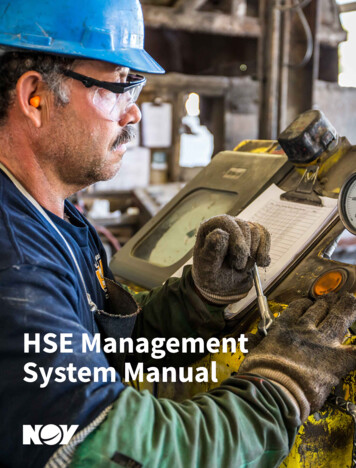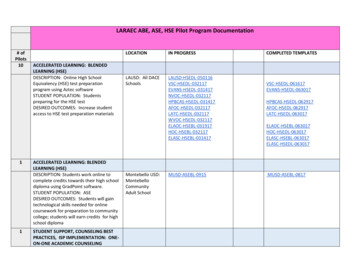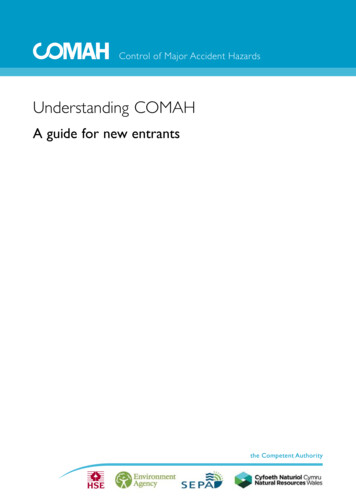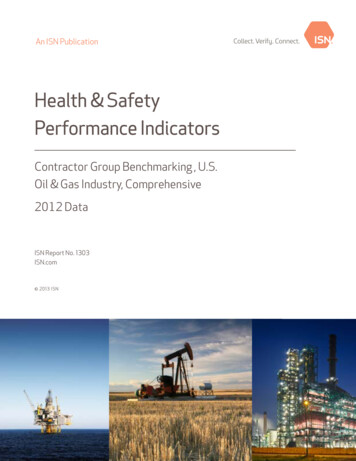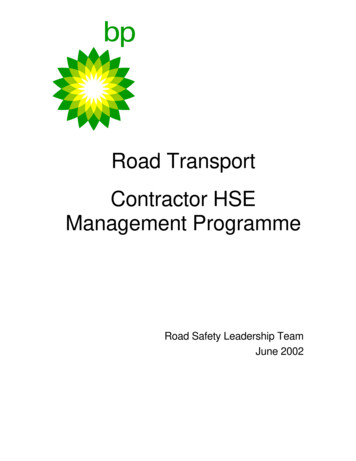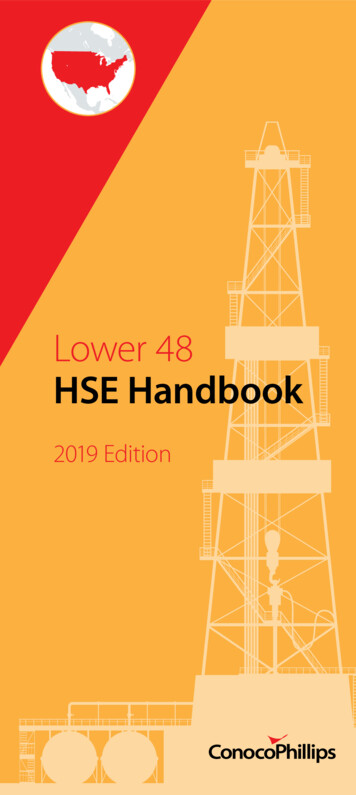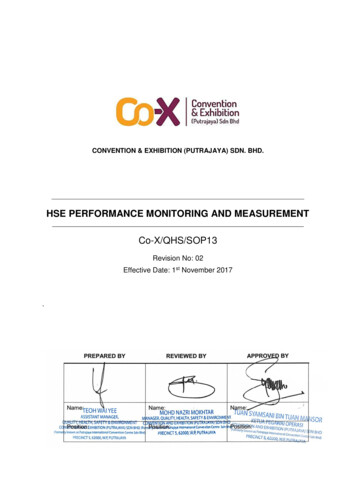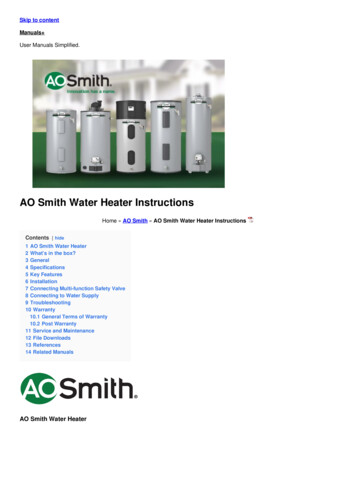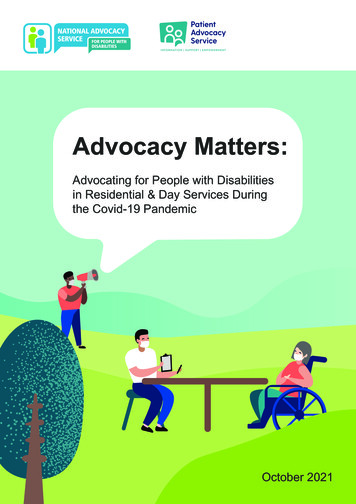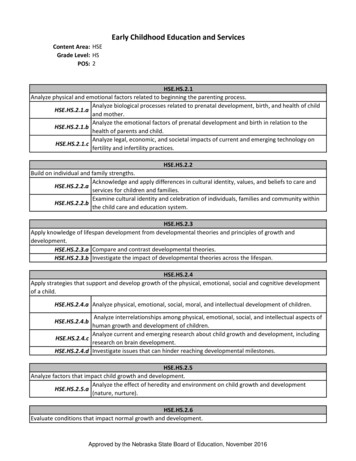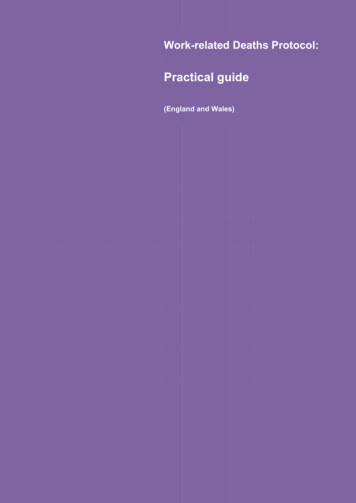
Transcription
Work-related Deaths Protocol:Practical guide(England and Wales)
Signatories to the Work-related Death ProtocolNational Police Chiefs’ Council (NPCC) - NPCC brings together the expertise andexperience of chief police officers from the UK, providing a professional forum to helpdeliver effective policing.Work-related deaths - the police will assume primacy for the investigation until anysuspicion of a homicide related offence is discounted. In all cases the police will work inpartnership with other investigating & enforcement agencies.British Transport Police (BTP) - BTP has responsibility for investigating all deaths on theRailway infrastructure and where appropriate will submit files to the CPS to considercriminal charges for offences of Murder, Manslaughter and Corporate Manslaughter. BTPwork closely with partners such as Office of Railway Regulation (ORR) and Rail AccidentInvestigation Branch (RAIB) to establish primacy for incidents and ensure relevant mattersare investigated.Chief Fire Officers Association (CFOA) - In England and Wales, Fire and RescueAuthorities are responsible for enforcing the Regulatory Reform (Fire Safety) Order 2005 inall premises with the exception of premises that are comprised in a house which isoccupied as a single private dwelling. Some Authorities also enforce explosives andpetroleum licensing requirements.Crown Prosecution Service (CPS) - CPS is the principal prosecuting authority forEngland and Wales and has responsibility for prosecuting all criminal charges resultingfrom work-related deaths, except cases where the only charges to be pursued are underthe Health and Safety at Work etc. Act. The CPS will only prosecute those cases inexceptional circumstances.Care Quality Commission (CQC) - CQC is the independent health and social careregulator in England. We regulate the provision of health and social care services by thoseregistered with CQC and prosecute unregistered providers.Care and Social Services Inspectorate Wales (CSSIW) - CSSIW is the independentinspectorate and regulator for social care in Wales. We regulate child care and social careproviders who are registered with CSSIW and take enforcement action against unregisteredproviders.Health and Safety Executive (HSE) - HSE enforces the Health and Safety at Work etc.Act 1974 in a range of sectors, including general manufacturing, construction, domestic gassafety, agriculture, public services & quarries, onshore major hazards (including mines,explosives, biological agents, chemical & petrochemical manufacturing) and offshore majorhazards (including oil & gas installations).Local Government Association (LGA) - Local Authorities in England enforce the Healthand Safety at Work etc. Act 1974 which covers a diverse range of work activities andworkplaces that have different levels of health and safety risk in a range of sectors,including retail, offices, wholesale / retail warehouses, hospitality & leisure (including hotels,camp sites, restaurants, night clubs, cinemas, social clubs, sports facilities, racecourses,pleasure boat hire, museums, theatres, art galleries), places of worship, undertakers,animal care, therapeutic & beauty services, care homes and private pre-school child care.Maritime and Coastguard Agency (MCA) - The Maritime and Coastguard Agency (MCA)is responsible for the, regulation and enforcement of safety standards in all shippingsectors. The Agency covers UK vessels anywhere in the world and foreign registeredvessels when within UK waters. MCA prosecutea on behalf of the secretary of state forTransport.MHRA Medical Devices Division - The MHRA is the UK regulatory authority for medicinesand medical devices. The Devices Division investigates all reported incidents involvingmedical devices used in hospitals, primary care and social care settings. We work closelywith the HSE, the Police and Coroners in cases involving patient deaths, as appropriate.Office for Nuclear Regulation (ONR) - ONR is responsible for regulating health and safetyon GB Nuclear sites, Authorised Defence sites, Nuclear Warship sites, and Nuclear NewBuild. ONR is responsible for the investigation of Work Related Deaths which may occur atthose sites.Office of Rail Regulation (ORR) - ORR is the independent safety and economic regulatorfor Britain's railways. We regulate health and safety for the entire mainline rail network inBritain, as well as London Underground, light rail, trams and the heritage sector.Welsh Local Government AssociationLocal Authorities in Wales enforce the Health and Safety at Work etc. Act 1974 in the samerange of sectors as in England (see Local Government Association for detail).
ForewordThe Work-related Deaths Protocol expects joint investigation of deaths in the workplace. Thepurpose of this Practical guide is to assist the police, enforcing authorities and prosecutors inthe joint investigation and where applicable, the prosecution of cases in relation to deaths inthe workplace. It is intended to be read in conjunction with the Work-related deaths: A protocolfor liaison document from which the core of the Practical guide has been drawn. This Practicalguide is not mandatory but gives practical guidance on the principles of liaison and jointinvestigation advocated by the Protocol.This guide is not a training document. It has been prepared on the assumption that thosetasked with investigating such serious and tragic matters, from whichever organisation, arequalified to do so. It provides a straightforward approach to the joint investigation of deathswithin the workplace. The guide, and the protocol, promote liaison with colleagues from otherenforcing authorities, and advocates that such liaison is not left to chance or to the discretionof the individuals involved.This guide also provides an event-driven timetable with liaison issues pertinent to each event.The Appendices contain checklists of actions to be taken by the first officer at the scene, thesupervisory officer and the senior investigating officer (SIO).In preparing the Practical guide, attention has been paid to the legislation that impacts upon allcriminal investigations. It also takes account of the specific guidance provided to Police fromACPO manuals, including those dealing with homicide, road deaths and the Human Rights Act1998. Equal account has also been taken of the Health and Safety Executive’s operatingpolicies, which are mirrored in guidance issued to other local authority agencies. The guideapplies to all work-related deaths including deaths within the signatory organisations.Police officers should be aware that in addition to conducting a criminal investigation for thepurpose of ascertaining whether a person (or company/ organisation) should be charged witha serious criminal offence (other than a health and safety offence), the relevant enforcingauthority1 has a responsibility to ensure dutyholders (who may also be suspects) takeimmediate action to deal with serious risks, and to promote and achieve sustained compliancewith the law.1 A relevant enforcing authority means the health and safety regulator with responsibility for the activity orworkplace involved and includes HSE, ORR, local authorities, MCA and the Fire and Rescue Services.
IntroductionThis Practical guide commences with a contents page, which seeks to encapsulate theProtocol on one page. This allows investigators to consider their actions within the context ofthe Protocol, and to navigate to the applicable section of the guidance. The appendices to thisguide list actions to be taken by the first officer at the scene, the supervisory officer and thesenior investigating officer (SIO).This guide was first published on the HSE website as the ‘Investigators Guide’ in March 2004and updated in September 2011 and May 2012. It was reviewed by the National LiaisonCommittee on the Work-Related Deaths Protocol (NLC) in 2014, re-named ‘Practical Guide’and published in February 2015. The guide is intended to be a living document, that is, it canbe updated and revised by the NLC as necessary.
Practical Guide ContentsSectionTitlePage1.Determining whether the incident is a Work-related Death?62.Initial Action.73.Management of Investigation.84.Decision Making.115.Disclosure of Material.136.Special Inquiries.147.Advice prior to Charge.168.Decision to Prosecute.179.The Prosecution.1910.HM Coroner.2011.National Liaison.2312.Local Liaison.23Appendix 1:Duties of First Officer.25Appendix 2:Duties of Supervisory Police Officer.29Appendix 3:Duties of Investigating Officer (SIO).31Appendix 4:Special Considerations.33Appendix 5:Where Police Have Primacy.34
1.Determining whether the incident is a Work-related deathA work-related death is a fatality resulting from an incident arising out of, or in connection with, work.The protocol and associated guidance also apply to cases where the victim suffers injuries that areso serious that there is a clear indication, according to medical opinion, of a strong likelihood ofdeath.Establishing whether a death is work-related can be difficult. On notification, relevant enforcementauthorities should liaise and agree on whether an incident is work-related. Each incident must beconsidered on its own merits, which may not be immediately apparent, and will therefore requireinitial enquiries to establish.Enforcing authorities will also be guided by their own internal policies, procedures & guidance indetermining whether a death is considered to be work-related. A decision should be made withoutdelay. The incident scene remaining secure until a decision has been made.Determining whether a death is work-relatedThe following questions may assist in determining whether a death is work-related:Is there, or was there a work activity or undertaking on-going at the time and place of the incident?Was the deceased / injured party an employee or self-employed person who was at work at the timeof the incident?Was the deceased / injured party a member of the public who was injured as a result of a workactivity?In the case of domestic or similar premises, has there been any recent maintenance orrefurbishment work undertaken e.g. work associated with gas or electrical installations orappliances?Examples of work-related incidents which are not immediately apparent could include: gas orelectrical incidents at rented accommodation; road traffic incidents; incidents in prisons or healthcare institutions and the collapse of buildings and other structures.DefinitionsWork means: work carried out by an employee or self employed person.Undertaking means: enterprise or business, whether carried out for profit or not.An employee is: an individual who works under a contract of employment, or an apprenticeship, theterms of which can be formalised orally or in writing, or the relationship can be informal or implied.Self-employed persons are: individuals who work for gain or reward, but not under a contract ofemployment. They may employ others.
2.Initial ActionIn most instances, the first person at the scene will be a police officer, but this may not always bethe case. Consequently, other relevant Enforcing Authorities who arrive in advance of the Police willbe expected to take appropriate action where they have the powers to do so.To assist the first officer at the scene, the following checklists are contained within Appendix 1:Duties of first officer – All Incidents.Additional duties of first officer – Domestic Gas Incidents.Additional duties of first officer – Road Death Incidents.Additional duties of first officer – Railway Incidents.Additional duties of first officer – Maritime Incidents.In all suspected work-related death cases, a police officer of supervisory rank should attend theincident scene to assess the situation, review actions taken to date and assume responsibility forthe investigation. To assist the attending supervisory officer attending, the following checklists areprovided in appendices 2 & 3.Appendix 2:Duties of supervisory police officer.Additional duties of supervisory police officer – Railway Incidents.Additional duties of supervisory police officer – Fire Incidents.Additional duties of supervisory policy officer – Incidents involving a MedicalDevice.Appendix 3:Duties of senior investigating officer (SIO)The checklists in Appendix 1 should assist the first officer at the scene to take the appropriateaction. However key actions to note on arrival at the scene are to: secure the scene of the incident; perform an initial risk assessment to ensure those investigating the incident are not exposedto significant health and safety risks; and, contact the relevant enforcing authority.On arrival at the scene, early questioning of potential witnesses, and even suspects, by the relevantenforcing authority may be necessary to establish whether there is a need to take immediate actionto address any residual risks which may exist post-incident. Such questioning may continue into theearly stages of a joint investigation to identify systemic underlying causes.
3.Management of the investigationWherever more than one enforcing authority has an interest in a death, the investigation of healthand safety and/or other offences should commence immediately, and be carried out in parallel to theinvestigation of manslaughter. Investigations should be jointly conducted, with one of the partiestaking the lead, i.e. assuming primacy. An investigation may also require liaison with other enforcingauthorities who have an interest, as well as the Crown Prosecution Service (CPS).Whilst one party will assume primacy, other parties to a joint investigation should by working jointlyand in parallel, progress their own investigation as quickly as practicable. Agreeing primacy shouldnot delay the investigations of individual parties to a joint investigation. At an early stage of theinvestigation, the police and other relevant authorities should agree:(a) who will assume/retain primacy;(b) a strategy for the on-going management of the joint investigation. This should include regularjoint reviews of the progress of the investigation;(c) lines of enquiry, either joint where applicable, or those to be investigated separately by theparties to the joint investigation;(d) what resources are required and how they are to be used/shared. This should include the use ofspecific powers by an enforcement authority (e.g. section 20 Health and Safety at Work etc. Act1974 or sections 62 to 65 of the Health and Social Care Act 2008) to ensure their use is necessary,justified and legitimate i.e. powers are only used for the purposes for which they were provided;(e) how relevant material gathered or generated during the investigation is to be recorded, stored,revealed and shared between the parties. Normally it would be appropriate for the parties to theinvestigation to share evidential material with each other, or permit access to it, as the investigationprogresses;(f) what specialist and expert advice is required; for what lines of enquiry i.e. gross negligencemanslaughter, corporate manslaughter or health and safety breaches; and how they are to becommissioned and funded. The aim is to ensure, where possible, that an expert addresses theissues in relation to all potential offences at the same time;(g) how the forensic examination of relevant material is to be co-ordinated eg. physical items, DNAevidence, digital material;(h) an interview strategy which establishes the identification of witnesses and potential suspects,including how, when and where they are to be interviewed. Interviews of witnesses and suspectsshould be jointly planned and conducted, covering all alleged offences whenever possible;(i) how, and to what extent, corporate or organisational failures should be investigated, and how andwhen advice will be sought from CPS. Normally it will be appropriate for the investigation to considerindividual and organisational failures in parallel;(j) a strategy for keeping the bereaved family/next of kin and witnesses informed of developments inthe investigation. Initially it is the police who will provide the necessary liaison. In the event ofprimacy passing to another enforcing authority, there should be discussion and agreement as to thebest way of maintaining communication with the bereaved family/next of kin and witnesses;
(k) liaison with HM Coroner, including the submission of factual reports to the coroner, disclosure ofrelevant material, and how any request for the coroner to suspend their investigation is to bepursued. Normally for an investigation of any length, it will be appropriate to make an application forthe suspension of the coronial investigation;(l) a media strategy to take into account the sensitivities of the bereaved family/ next of kin andothers involved in the incident, the messages which all parties investigating the incident wish toconvey, and to encourage consistent reporting. Normally it will be appropriate to consult with allparties in the investigation in relation to the timing and content of any media activity.In large-scale investigations it may be beneficial to form a strategic liaison group to ensure effectiveinter-organisational communications, and to share relevant information, good practice andexperiences.Sharing InformationNormally there should be no legal barriers to sharing relevant information. However, in some casesit may be appropriate to set out in a written agreement what information will be shared, when andhow it will be shared and the legal basis for doing so.Monitoring / Reviewing Investigation ProgressThroughout the joint investigation, the police and other relevant enforcing authority should keep theprogress of the investigation under review. Milestones should be agreed and monitored, and policyand key decisions recorded in Key Decision Logs (when used) by each authority. Whilst allinvestigations will be managed differently, it is suggested that in cases where primacy remains withthe police at 3 months post incident, a comprehensive review of the investigation is carried out bythe police and the relevant enforcing authority.The review should be jointly conducted and involve the police, CPS and relevant enforcing authorityand should: assess progress;review the evidence obtained to date and seek advice from the CPS, if not already obtained,on whether the investigation into potential negligent homicide(1) should continue;where the police are to retain primacy for the investigation, agree (unless there is a goodreason) that the CPS seek suspension of the coronial investigation(2), and the adjournmentof any associated inquest; andwhere there is no evidence of a negligent homicide offence, agree how and when primacyshould be passed to the relevant enforcing authority.Reviews between parties to a joint investigation should be conducted at regular intervals to ensurethe investigation and any resulting prosecution can be completed as quickly as practicable. It isrecommended that, where necessary, key reviews are undertaken at the 1st and 2nd anniversariesof the date of death. The overall aim is to ensure that investigations are completed, and anydecision to prosecute made, as quickly as possible. All parties should aim to ensure that anyprosecution is brought as soon as possible and except in exceptional circumstances no later than 3years after the death.In cases where CQC are investigating criminal offences, shorter time-scales may apply due tostatutory time-limits on certain offences. This should be discussed and agreed between parties to ajoint investigation.
EscalationIt is important when investigations have stalled that there are clear processes in place to ensureissues delaying investigations can be escalated to a senior level in an efficient and effectivemanner. The names and contact details of individuals of immediate seniority, and one level beyond,i.e. two levels of seniority above, lead investigator / senior investigating officer should be providedand shared by the police, CPS and relevant enforcing authority.DelayInvestigators should be at all times be conscious of, and avoid any unnecessary delay in theprogress of the investigation. Following the principles of the protocol and this guide should assist inavoiding undue delay.(1)Negligent Homicide means ‘Serious criminal offence other than a health and safety offence.(2)Coroners powers to suspend an investigation under Schedule 1 (Section 11) of the Coroners and Justice Act20091 (1) A senior coroner must suspend an investigation under this Part of this Act into a person’s death in the followingcases.(2) The first case is where a prosecuting authority requests the coroner to suspend the investigation on the ground that aperson may be charged with—(a) a homicide offence involving the death of the deceased, or(b) an offence (other than a service offence) that is alleged to be a related offence.
4.Decision MakingGross Negligent Manslaughter (GNM) and Corporate Manslaughter (CM)Whenever there is a suspicion that a negligent homicide may have caused the death, the police willassume primacy for an investigation and work in partnership with other relevant enforcingauthorities.For gross negligence manslaughter (GNM) and corporate manslaughter (CM) to be considered bythe CPS, the conduct of those suspected of breaching the law must fall far below that expected ofthe reasonable practitioner. A single mistake, even if serious, is unlikely (although it is notimpossible) to meet this criteria. There must be an element of real badness rather than someonedoing their inadequate best in difficult circumstances.Negligence by a number of people cannot be aggregated to mean that altogether their conduct fellfar below the required standard. All those suspected of breaching the law must be consideredindividually. The police are advised to make contact with the CPS at the earliest opportunity toensure that consideration of possible corporate manslaughter or gross negligence manslaughtercharges can be made promptly. The CPS has specialist lawyers to assist police colleagues whomay not have much experience of the crime involved in these cases.Success in the prosecution of these cases will depend upon a careful, incremental case-buildingstrategy, drawing upon reports from one or more technical experts, and are often undertaken inliaison with other investigative agencies. Working with the CPS to identify other key agencies at theearliest stages will be essential to ensuring the effective management of case progression.The legal test for manslaughter by gross negligence is set out in R v Adomako (1995 1 AppealCases 171). It is a four stage test, and the essential elements to be established are:(i) the defendant owed a duty of care towards the deceased; and(ii) the defendant breached that duty of care; and(iii) the breach caused or significantly contributed to the death; and(iv) the breach should be characterised as gross negligence and therefore a crime.For corporate manslaughter, there are a number of elements to the offence which need to beproved:(a) the defendant is a qualifying organisation;(b) the organisation caused a person’s death;(c) there was a relevant duty of care owed by the organisation to the deceased; and(d) there was a gross breach of that duty which fell far below what was reasonably expected ofthe organisation in the circumstances.Additionally, for corporate manslaughter, the conduct (the way in which the company’s activitieswere managed or organised) of senior management must be a substantial part of the corporatefailing. Senior management are those who make decisions about how all or a large part of thecompany’s conduct is managed or organised.
In deciding whether there has been a gross breach of duty, the jury must consider whether anyhealth and safety legislation was breached, and if so must consider:(i) the seriousness of the breach; and(ii) how much of a risk of death it posed.The bar to prove GNM and/or CM is therefore set very high and, if at any stage of the investigation,it becomes apparent that it is unlikely that there will be sufficient evidence to prove such an offence,primacy should be assumed by the relevant enforcing authority as expediently as possible.The CPS will work closely with the enforcing authority assuming primacy, to ensure that in caseswhere the decision is reached not to pursue a prosecution in relation to a negligent homicide, thatthis is properly communicated.Change of Primacy and Investigation HandoverBoth parties should record in writing the change of primacy in writing by completion of a handoverdocument. The formal handover process should include the transfer of relevant investigationmaterial (statements, photographs, physical items, documents etc.) not already passed to theauthority assuming primacy. Relevant material retained by the police, either for Public InterestImmunity (PII) purposes or some other reason, e.g. safe storage, notebook entries, must also berevealed to the authority assuming primacy to ensure they can comply with the Criminal ProcedureInvestigation Act 1996 (CPIA).Handover can occur very early in the investigation process and, in the case of some incidents, mayoccur after the police have carried out initial enquiries only. A handover document has beenproduced by the NLC for use in such circumstances.Where an evidential review in relation to a negligent homicide offence is informed by legal advicefrom the CPS, the process should be carried out as expediently as possible. Where the evidentialtest is not met, primacy for the investigation should be transferred as soon as possible.Where an enforcing authority other than the police has primacy and new information is discoveredwhich gives cause to reconsider whether a negligent homicide offence has been committed, theinformation should be shared with the police as soon as possible. The police should decide whetherto re-assume primacy, consulting the CPS if necessary. Where the police re-assume primacy, afurther handover document must be prepared by the enforcing authority passing primacy. Handovershould include the transfer of relevant material not already in the possession of the police.There will also be rare occasions where, as a result of the coroner’s inquest, judicial review or otherlegal proceedings, further consideration of the evidence and surrounding facts may need to bemade. Where this takes place the police, the relevant enforcing authority with primacy for theinvestigation and the CPS will work in partnership to ensure an early decision. There may also be aneed for further investigation.
5.Disclosure of materialTo comply with the requirements of the Criminal Procedure Investigations Act 1996 (CPIA), HomeOffice Code of Practice (CoP) under Part II of the Criminal Procedure and Investigations Act 1996,and the Attorney General’s Guidelines on Disclosure, enforcing authorities should retain and recordall relevant material gathered or generated during the investigation.Effective management and liaison should ensure that enforcing authorities jointly investigating anincident have access to all relevant material as it is gathered during the investigation. However,even with effective material management and liaison systems, there may well be additional material,both used and unused, which has not been revealed and shared between authorities, either duringthe investigation or on handover where primacy for an investigation changes.Enforcing authorities who have investigated an incident, regardless of the level of involvement,should therefore ensure that all material is revealed and disclosed to another authority when such arequest is received. On revelation and/or receipt, the material should be recorded and categorisedaccordingly by the receiving authority.Effective liaison between enforcing authorities should ensure that the required procedures arefollowed where there is an application to the court to withhold sensitive material which wouldotherwise fail to be disclosed on the grounds of a risk of serious prejudice to an important publicinterest.In large and complex investigations which result in prosecution, the approach to disclosure shouldbe outlined in a Disclosure Management Document by the prosecuting authority. The documentshould include the steps taken to obtain material in the possession of other enforcing authorities i.e.third party material.
Part 6: Special InquiriesHealth and Safety ExecutiveIn the case of some incidents, particularly those involving multiple fatalities, HSE may, with theconsent of the Secretary of State direct that a public inquiry be held. Alternatively, the HSE Boardmay authorise HSE, or any other person, to investigate and produce a special report.In such circumstances, the police will provide any necessary support and evidence to the personappointed to conduct the public inquiry, or to the special investigation, subject to the relevantregulations.Complex legal issues may arise when there are parallel public inquiries and criminal investigationsor prosecutions. The signatories will aim to keep inquiry chairs informed of the progress of theinvestigation.Sometimes the report of a public inquiry may be delayed to await the conclusion of criminalproceedings, and on other occasions, there may be no such delay because of strong public interestin publishing the report and the recommendations of a public inquiry quickly. In either event, thesignatories to the protocol will work together to ensure that the decision to prosecute is made asexpeditiously as possible and any criminal proceedings commenced without delay.Care Quality CommissionIn exceptional circumstances and only at the request of or with the approval of the Secretary ofState, CQC may conduct a special review or investigation pursuant to Section 48 of the Health andSocial Care Act 2008.Investigation involving Accident Investigation Branches (‘Safety Investigations’)“The UK has international legal obli
Work-related deaths - the police will assume primacy for the investigation until any suspicion of a homicide related offence is discounted. In all cases the police will work in partnership with other investigating & enforcement agencies. British Transport Police (BTP) - BTP has responsibility for investigating all deaths on the
